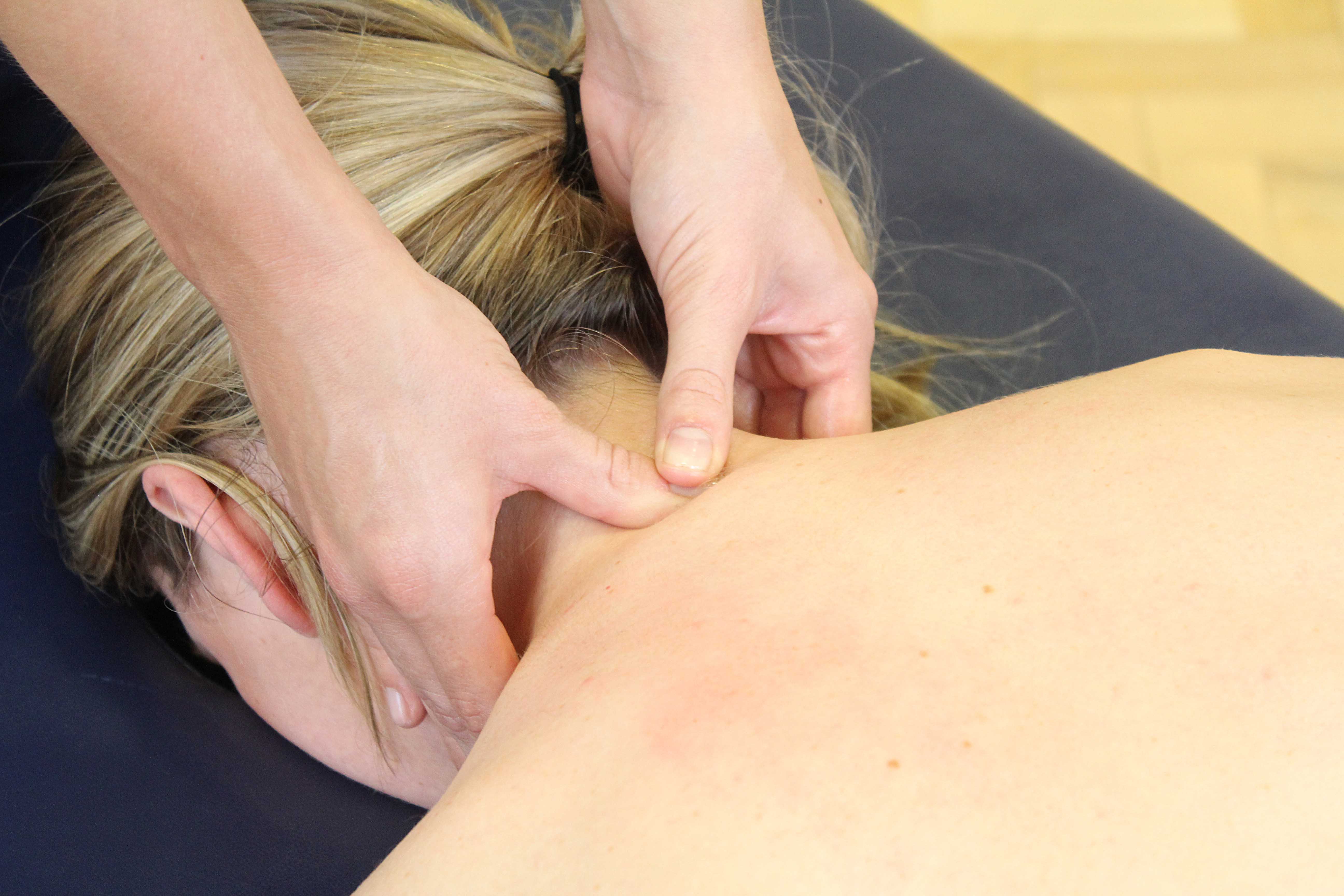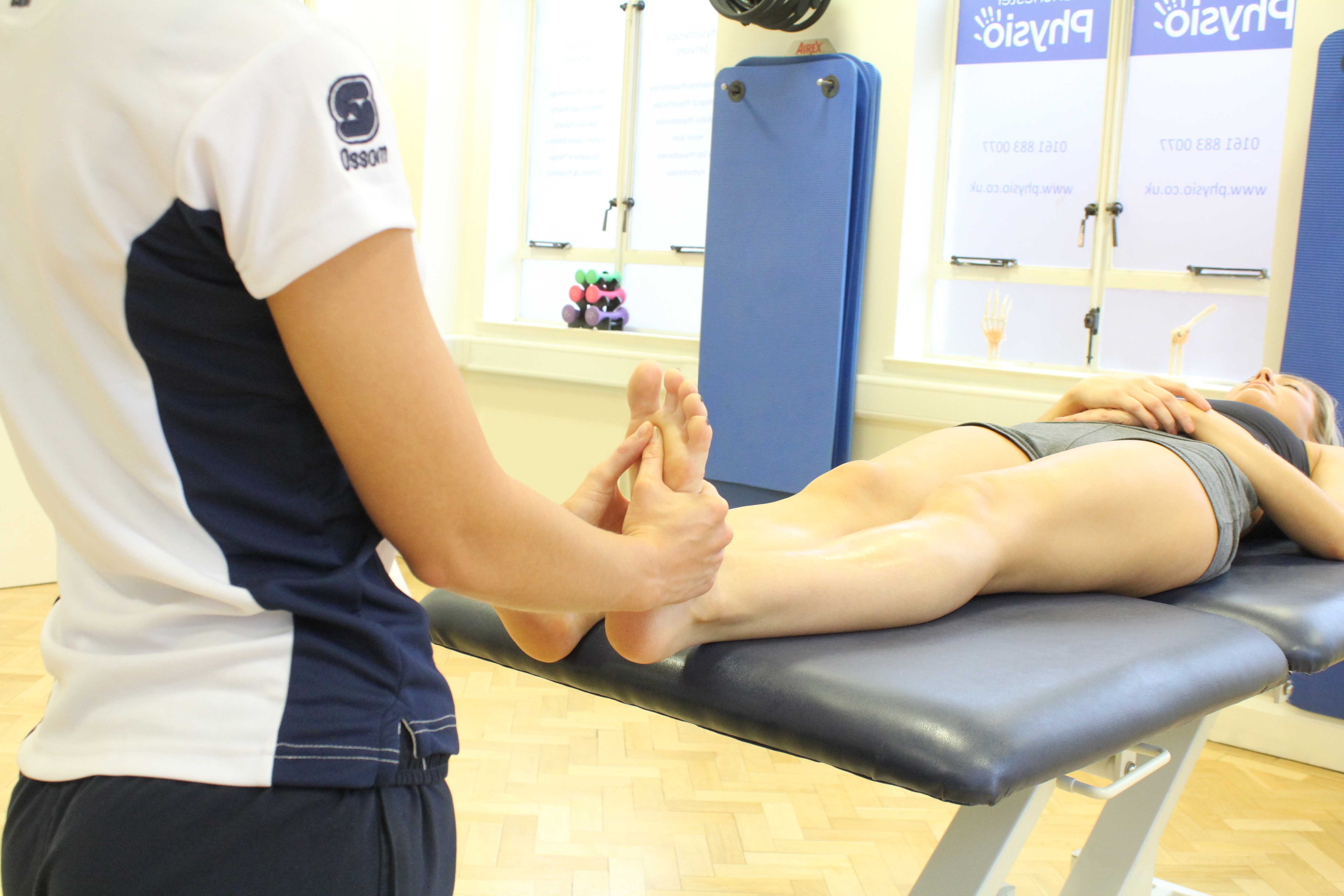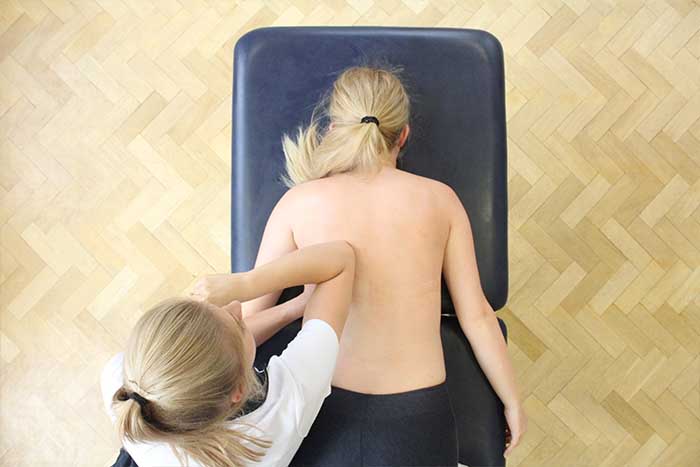Chronic pain can be reduced through massage. For a pain to be termed as "chronic" it will be ongoing pain lasting 12 weeks or more. Chronic pain can arise for a range of reasons. The most common causes of chronic pain are injury or long term illness. Chronic pain can occur in any part of the body and can increase stress, anxiety and sometimes depression. A massage aims to disturb the pain cycle in order to reduce and relieve any pain and prevent it from reoccurring. Our massage therapists at Physio.co.uk use massage for chronic pain in order to reduce stress and increase relaxation.
What type of massage is used for chronic pain?
A variety of massage types can be used for chronic pain. The most common massage types used include:

When can massage help chronic pain?
Reducing chronic pain through massage can help on a variety of occasions. Occasions when massage can help chronic pain include:
 Above: Massage of cervical spine and trapezius muscles to reduce chonic pain symptoms
Above: Massage of cervical spine and trapezius muscles to reduce chonic pain symptomsA massage can help to decrease pain. Pain can arise for a variety of reasons. Common causes of pain include injury, trauma or muscle overuse. Pain occurs when receptors within the skin detect something isn"t right. The receptors will then send a signal to the brain where it is then passed on to nerves. Nerves are what create a feeling of pain. A massage aims to reduce pain by increasing healing and disturbing the pain signals sent to the brain. During a massage, the skin and fingers create friction. Friction encourages blood flow to increase. Oxygen and nutrients are carried within the blood flow. Oxygen and nutrients are essential for the repair of damaged muscle fibres. Increasing blood flow therefore increases the rate of healing helping to reduce pain. The friction created between the skin and fingers, also creates a new sensation. The new sensation is picked up by the receptors within the skin, disturbing the signal sent to the brain. Disturbing the signal sent to the brain means fewer messages are sent to nerves to create a feeling of pain. A new message encouraging relaxation and decreased pain is sent to replace the original message. Disturbing the signal sent to the brain therefore reduces pain.
A massage for chronic pain can help decrease tension. Tension is where muscles are unable to relax and stay in the state of contraction. Tension can cause muscular knots to form and muscle tightness to increase, further increasing feelings of chronic pain. Chronic pain can increase tension due to a restriction in movement. Movement is restricted to prevent pain and damage from increasing. A massage for chronic pain can reduce tension by encouraging relaxation and increasing range of movement. During a massage, muscle temperature increases due to an increase in blood flow. When muscle temperature increases, the elasticity and flexibility of tissues increase and muscles are able to loosen and stretch. When muscles loosen and stretch, relaxation increases, reducing tension. An increase in tissue elasticity and flexibility, improves range of movement to help further reduce a build-up of tension. Reducing tension by improving range of movement and increasing relaxation also helps to decrease pain.
Stress can be reduced through massage for chronic pain. Chronic pain increases stress due to the long period of restricted movement, increased pain and disability to carry out normal everyday activities. Chronic pain can cause stress to increase both physically and mentally. Stress increases physically by restricting movement, causing muscles to tighten and the ability of muscles reaching its full length to decrease. Stress is increased mentally by chronic pain due to a stress hormone called cortisol. A massage aims to reduce stress by encouraging relaxation of muscles and reducing cortisol levels. Relaxation is increased due to an increase in muscle temperature. Increasing muscle temperature allows muscles to relax by increasing tissue elasticity. Increasing relaxation decreases physical symptoms of stress. A massage stimulates the production and release of feel good hormones. Feel good hormones include endorphins, serotonin and dopamine. Feel good hormones are responsible for increasing mental relaxation providing a sense of well-being whilst also reducing stress. Feel good hormones replace cortisol to help further reduce stress.
 Above: Massage of planta fascia to reduce chronic pain
Above: Massage of planta fascia to reduce chronic painWhat are the physiological effects of receiving a massage for chronic pain?
Massage can have many physiological effects on the body. The physiological effects of massage for chronic pain are:
The most common physiological effects of massage for chronic pain include increased temperature, removal of waste products and increased endorphins, serotonin and dopamine.
An increase in temperature occurs throughout a massage for chronic pain. Temperature can increase within both superficial and deep layers of muscle tissues as well as within the layers of fascia, a tough layer of fibrous connective tissues. A range of techniques that are used within a massage create friction between the skin and fingers. Friction stimulates an increase in blood flow to occur to the treatment area. An increase in blood flow as well as friction both increase temperature. Increasing temperature through massage for chronic pain helps to relieve muscle tightness and tension as well as increase relaxation and reduce stress. Relieving tightness and tension, increasing relaxation and reducing stress all through an increase in temperature help to reduce symptoms of chronic pain.
A massage for chronic pain increases the removal of waste products. Waste products can build up within muscles causing muscle weakness and fatigue. Muscle weakness and fatigue can prolong the effects of pain resulting in chronic pain increasing. The removal of waste products occurs within the lymphatic system. The lymphatic system is made of tiny lymph vessels that transport lymph fluid around the body towards glands and nodes. The lymph fluid contains the waste products and the glands or nodes it is transported to, is where the waste products are removed from the body. The most common types of glands are sweat glands which are most often found in the armpit, groin and behind the knee. During a massage stimulation of the lymphatic system occurs. Stimulation of the lymphatic system causes lymph flow to increase. An increase in lymph flow rises the amount of waste products that are picked up in the lymph fluid and transported to the glands and nodes to be removed. Increasing the amount of waste products being removed from the body, reduces muscle weakness and fatigue therefore reducing pain.
An increase in endorphins, serotonin and dopamine occurs within a massage for chronic pain. Endorphins, serotonin and dopamine are feel good hormones that are circulated around the body within the blood flow. Endorphins, serotonin and dopamine are responsible for positive feelings we may get. Some positive feelings that can occur include increased relaxation, reduced stress, a sense of well-being, relieved anxiety and an increase in motivation. Chronic pain is often increased due to a constant feeling of stress. When stress levels are too high, this can also cause depression and anxiety to occur which can further worsen the pain. A massage stimulates the autonomic nervous system which is responsible for the release of the feel good hormones. As well as stimulating the autonomic nervous system, a massage also increases blood flow which the hormones are carried within. Stimulation of both the autonomic nervous system and the blood flow both encourage an increase in endorphins, serotonin and dopamine to occur. Increasing feel good hormones help to reduce pain by relieving stress, depression and anxiety and replacing the feelings with relaxation, happiness and enthusiasm.

What are the benefits of receiving massage for chronic pain?
There are many benefits of receiving a massage for chronic pain. The benefits of a massage for chronic pain are:
A massage for chronic pain can increase range of movement. When damage occurs to the body, muscles often contract around the area to prevent any further damage from occurring. When muscles contract, tension increases and movement is restricted. Long term damage can cause the restriction to prolong, increasing pain and stress. Within a massage, friction created between the skin and fingers increases blood flow to the treatment area. An increase in blood flow causes muscle temperature to rise. A rise in muscle temperature helps to relax and loosen muscles causing muscle tightness and tension to reduce. Increasing muscle temperature also reduces tissue in-elasticity. A reduction in tissue in-elasticity allows muscle to stretch to their full length, increasing range of movement. When range of movement is increased through a reduction in muscle tightness and tension, pain is also reduced.
One benefit of massage for chronic pain is increased relaxation. When chronic pain occurs, relaxation levels can decrease due to the inability of carrying out normal daily activities, a restriction in movement and the constant feeling of pain. A massage aims to increase relaxation both physically and mentally. A massage can physically increase relaxation by relieving restricted movement. Movement is most commonly restricted due to an increase in muscle tightness and tension. A massage helps to relax and loosen muscles by increasing muscle temperature resulting in an increase in range of movement. Increasing range of movement can decrease pain and therefore increase relaxation. A massage increases relaxation mentally by stimulating the release of positive hormones. Positive hormones include endorphins, serotonin and dopamine and have the responsibility of reducing stress, anxiety and depression whilst increasing relaxation, happiness and motivation. Increasing the level of positive hormones within the body through massage further increases relaxation.
Muscle tightness is relieved through massage for chronic pain. Muscle tightness increases when a person is suffering from chronic pain. Muscle tightness occurs to restrict any excess movements that could cause pain to increase or damage to worsen. However muscle tightness itself increases pain. A massage aims to reduce muscle tightness by increasing blood flow in order to improve tissue elasticity. Blood flow is increased during a massage due to friction created between skin and fingers. Blood flow is used to raise muscle temperature. Tissue elasticity improves when muscle temperature rises, allowing muscles to relax and tightness to reduce. Relaxation of muscles reduces restriction and therefore pain.
Summary
Chronic pain is a pain that has occurred most commonly by injury or illness and can last 12 weeks or more. There are various massage types suitable for the relief of chronic pain including sports massage, deep massage, remedial massage and therapeutic massage. A massage for chronic pain can help decrease pain, decrease tension and reduce stress. Many physiological effects occur during massage for chronic pain, the most common being increased temperature, the removal of waste products and increased endorphins, serotonin and dopamine. A range of benefits including increased range of movement, increased relaxation and the relief of muscle tightness can all be gained through massage for chronic pain. Our massage therapists at Physio.co.uk use massage for chronic pain to help improve movement and decrease anxiety.
When I am in chronic pain how can I arrange a massage?
The easiest way to arrange a massage to treat chronic pain at Physio.co.uk is to email us at office@physio.co.uk or call us on 0800 033 7800.
You can also book an appointment online and save £10

 0330 088 7800
0330 088 7800


































